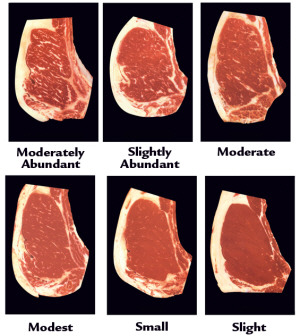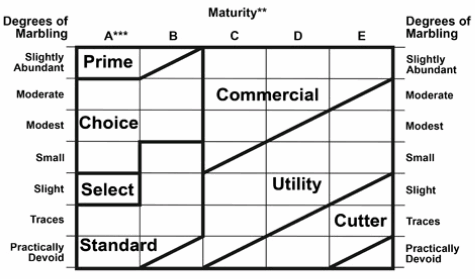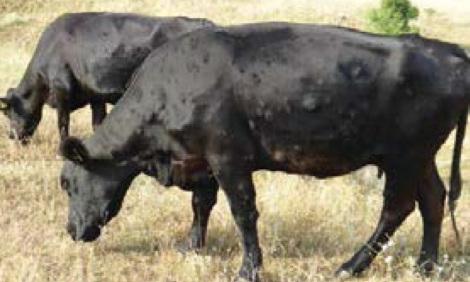



Beef Grades
By Chelsea Good, CAB Industry Information. This is a report from the Certified Angus Beef Brand. The following information applies to the United States grading system. When the meat grader stamps a side of beef with a U.S. Department of Agriculture (USDA) quality grade, he is estimating its palatability.
That stamp of approval on a Choice or Prime carcass predicts quality so that consumers have the confidence to pay more. Producers who sell in a valuebased system also earn more. But how do the graders decide which stamp to use? What separates a Choice carcass from a Select?
History
The USDA began developing grades for beef carcasses in 1916. Designed to offer uniformity when reporting livestock markets, the grades were put to the test when used for ordering meat during World War I.
“After the war, quality grades were incorporated into hotel, restaurant, dining car service and hospital buying, similar to the way retailers use grades to order meat today,” explains John Unruh, Kansas State University meat scientist.
While there have been adjustments throughout the years, Colorado State University meat scientist Daryl Tatum says the fundamentals of the system remain.
Marbling
The primary quality grade factor for young cattle is marbling, or the intramuscular fat within the ribeye lean. Graders evaluate this after the carcass has been cut between the 12th and 13th ribs, or “ribbed.” The amount of marbling in the ribeye is described by specific Marbling Scores, from “Abundant” for high Prime to “Slight” for the Select grade, and lower scores for even lower grades.
CHART 1

Photo: NCBA/USDA
These scores correspond to initial quality grades, but other characteristics come into play. Desirable ribeyes exhibit an adequate amount of finely dispersed marbling within firm, fine-textured, bright, cherry-red colored lean, Unruh says. As an animal matures, these muscle characteristics transform.
Maturity
Cattle develop at different rates. Maturity refers to the physiological development of an animal rather than the chronological age.
“Maturity is really a composite evaluation of a couple of things,” Tatum says. “One has to do with the skeletal characteristics and the other relates to the color and texture of the lean.”
As cattle mature, their cartilage gradually turns to bone, he explains. This process, called ossification, helps graders determine a bone maturity grade. Maturity grades range from A to E as more ossification along the backbone becomes evident. Graders also look at the shape and color of the rib bones when determining bone maturity grade.
This classification is then adjusted based on the color and texture of the lean.
“As animals mature, the color of their muscle changes from a bright pink to a dark purplish-red color,” Tatum says. “The texture of the lean on the cut surface of the ribeye also gets coarser.”
When combining skeletal and lean maturity, the overall maturity classification won’t vary more than one grade from the bone maturity score.
The following table shows the approximate ages corresponding to the carcass maturity grades.
| Carcass maturity | Approximate live age |
|---|---|
| A | 9 - 30 mos. |
| B | 30 - 42 mos. |
| C | 42 - 72 mos. |
| D | 72 - 96 mos. |
| E | > 96 mos. |
Final Quality Grade
The final quality grade is determined by the graders’ quick calculations of where maturity and marbling scores meet (See Chart 2). Carcasses of greater maturity aren’t eligible for the most desirable quality grades, regardless of the amount of marbling. However, Tatum says most of the cattle finished in the United States fall into the “A” maturity range. That’s why degree of marbling tends to be the determining factor.
Chart 2, Source: USDA
Relationship Between Marbling, Maturity and Carcass Grade*

**Maturity increases from left to right (A through E)
*** The A maturity portion of the figure is the only portion available to bullock carcasses
Yield Grades
In 1965, yield grades were added to create a dual grading system.
“Yield grades were added to predict the red-meat yield of the carcass,” Tatum says. “They predict what percent of a carcass is closely trimmed, boneless, saleable product.”
Yield grades range from 1 to 5, with 1 being the most desirable. The grade factors in amount of external fat, hot carcass weight, amount of internal (kidney, pelvic and heart, or KPH) fat and area of the ribeye muscle.
Branded beef
“Branded beef programs use the grading standard as a basis for selecting carcasses or products that they’re going to promote in their systems,” Unruh says. However, these often have stricter specifications than the USDA grades. “By narrowing the variation, they are targeting specific markets,” he notes.
For example, the Certified Angus Beef ® (CAB®) brand has 10 specifications for beef that qualifies for the program. About 90% of eligible cattle that fail to qualify for CAB fall out because they have less than a Modest amount of marbling. Only the upper two-thirds of Choice Angus carcasses may qualify for the program.
“The same graders who stamp USDA grades also certify carcasses for CAB,” Tatum says.
USDA grades are important in the segregation of carcasses, Unruh says. But the additional branded program stamps allow companies to find and promote beef that has more value for producers, retailers, restaurant managers and consumers.
January 2008



